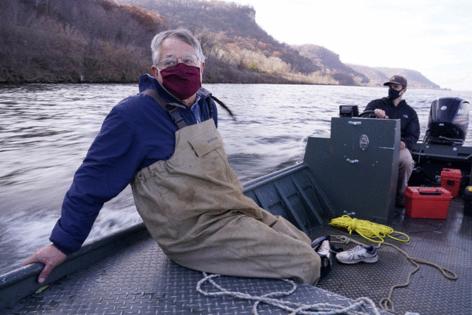Dennis Anderson: Are we going to save Minnesota waters from carp, or not?
Published in Outdoors
In a career spanning nearly four decades, University of Minnesota professor Peter Sorensen has researched invasive fish from Australia to the Great Lakes. For the past five years, he's focused on Lock and Dam 5 in the Mississippi and believes the lock there is an ideal location to install a deterrent to keep silver and other invasive carp out of Lake Pepin and the St. Croix River, among other Minnesota waters. In the interview below, Sorensen says the need for the deterrent is urgent, and that not installing one is "environmentally irresponsible."
Q: The DNR's recently released carp plan says installation of a deterrent at Lock and Dam 5 — if the agency ultimately agrees one is needed — could safely wait until 2028. Do you agree?
A: Absolutely not. If you look at the time frame in which silver carp have moved upstream in the Mississippi, you can reasonably estimate they will be past Lock and Dam 5 in five years and perhaps less. My view is we should start installation as soon as possible.
Q: How long would installation take?
A: Including Army Corps of Engineers permitting, as much as five years, but hopefully only two or three years. Construction can only occur in winter, when the lock is shut. So even if we start later this year, we're cutting it extremely close. The appropriation given the DNR last year, $1.7 million, was intended to get an engineering study done, or at least started, which is the predecessor action to working with the Army Corps of Engineers for a permit. But the DNR hasn't yet contracted with an engineering company. In the end, if you know a train is coming toward you and you can accurately estimate its speed, your two choices are stopping the train — in this case by building a deterrent — or jumping off the track. That's where we're at.
Q: The DNR talks about the importance of installing a deterrent at Lock and Dam 19 in Iowa. Assuming that could get done at some point, and none is planned at this time, would it be a viable substitute for a Lock and Dam 5 deterrent?
A: The U.S. Geological Survey has an experimental deterrent at 19, and if a permanent deterrent like it could be installed there that would be great, particularly for snakeheads and other invasives which, we think, are not yet north of there. But invasive carp are already breeding north of 19. So while placing a deterrent at 19 makes sense, and perhaps Iowa, Wisconsin and the federal government would help pay for it, regarding Minnesota and the possibility of invasive carp in Lake Pepin and the St. Croix, that horse has left the barn. Invasive carp are already breeding north of 19.
Q: The Lock and Dam 5 deterrent cost estimate last year was $15 million to $17 million. This year the ask has dropped significantly. What's your current estimate of a Lock and Dam 5 deterrent cost?
A: The installation company has given us new estimates, which are $6 million to $8 million and possibly less. Last year's estimates were based on the assumption the DNR would have no role in running it; the deterrent instead would be automated and operated remotely by the company that installed it. If we assume a minimal role for the DNR, the costs could be cut considerably. All of this is premised on getting the engineering plan done, which should have been done by now.
Q: The DNR has said it wanted to complete its almost yearlong "structured decision-making process," for which it paid more than $70,000, before it contracted for a deterrent engineering report. Could both have been done concurrently?
A: Absolutely. My lab has a research project at Lock and Dam 5, and we got the whole shooting match done in nine months. You just hire an engineering company to do the work. Locally, Barr Engineering had a big role in installing a similar deterrent in Kentucky, and I think it would take them only a few months to do the required 60 percent design and engineering study. It's frustrating, frankly, that the DNR to this point hasn't got it done.
Q: Some have argued a deterrent would only be 50% effective.
A: That's incorrect. I describe it this way. I live in an old house, and every winter, mice try to come in. So we combine a bunch of strategies to keep them out. Fill holes, traps, etc. It's the same here. The deterrent would be the keystone, but other deterrents, such as the trapping and netting of carp the DNR is now doing, would work in combination. All deterrents together would be in the high 90% effectiveness range.
Q: In the last legislative session, DNR assistant commissioner Bob Meier, acting on behalf of Commissioner Sarah Strommen, told legislators not to approve a Lock and Dam 5 deterrent. Gov. Tim Walz also has been AWOL on the issue, and Friends of the Mississippi River and other conservation groups say a top aide of his canceled a meeting Monday with them where they intended to ask for the governor's support. Why do you think the agency and Walz haven't supported building a deterrent, at least so far?
A: I have no idea. But it's got nothing to do with science, I can tell you that. You can estimate when the fish will be farther north, which we've done. Add in the economic, recreational and biologic valuations of the Lake Pepin, Mississippi and St. Croix river ecosystems and the damage that would be done to them, which would be incalculable and irreversible, and you make a reasoned decision. Doing nothing, in my view, is environmentally irresponsible.
©2024 StarTribune. Visit startribune.com. Distributed by Tribune Content Agency, LLC.







Comments